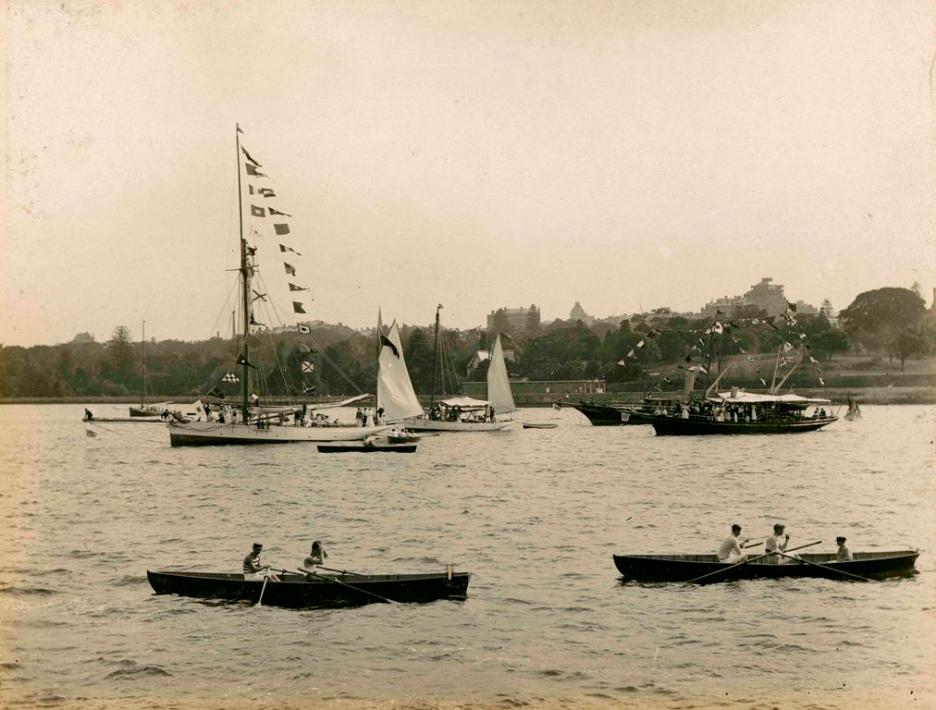June 2 - 28, 2014: Issue 168
Port Jackson Pleasure Fleets - 7 & 8
Steam Yachts, Nights Under Barrenjoey and the Development of Classes in Racing Yachts
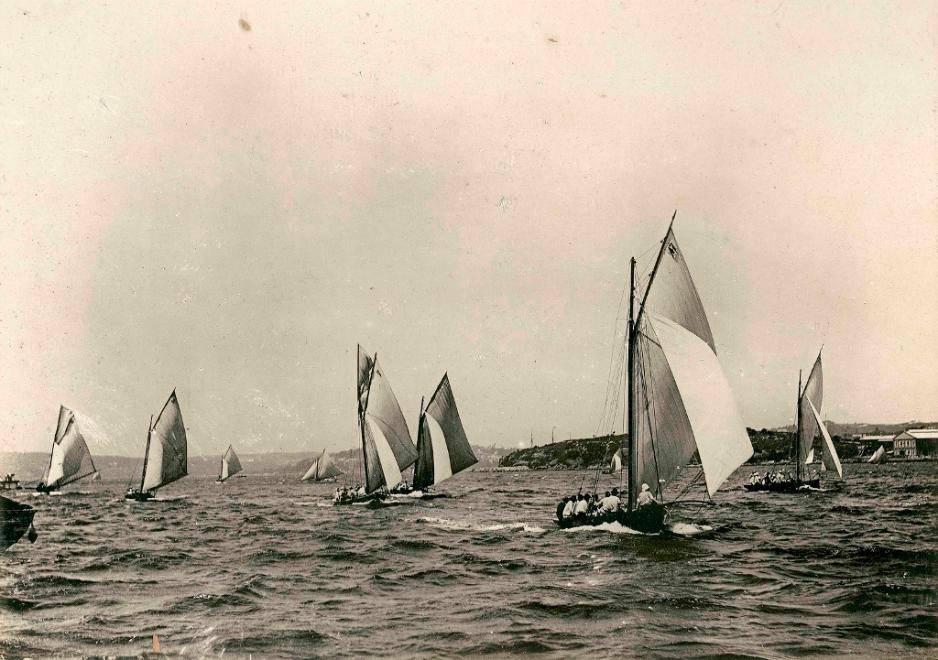
Prince Alfred Yacht Club Regatta - 1895 - ANMM Collection 00019553 [08], courtesy Australian National Maritime Museum
Loud and sudden there was heard,
All around- them, and below,
The sound of hammers, blow on -blow,
Knocking away the shores and spurs,
And see! She stirs!
She starts — she moves — she seems to feel
The thrill of life along her keel,
And., spurning with her foot the ground,
With one exulting joyous bound
She leaps into 'the ocean's arms.
— Longfellow
Who was it said when a ship is launched a child is born to the ocean? As a rule, there is not much poetry about the launching of one of our yachts; we follow British custom at such a function just as, regardless of the difference in condition's here, we feast on roast beef and plum pudding at Christmas. Still, our ceremony is in advance of the old Fijian one of launching a war-canoe over the prostrate bodies of friends and relatives, if the -supply of enemies did not meet the demand; but it is distinctly behind the Norman ceremony of the christening of a vessel. Alphonse Karr, in one of his books, gives the, following description of the naming of a fishing boat on the coast of Normandy. The bells were ringing at the village church; the chanting of the priest, the clerk, and the choir was heard; -they brought a crucifix, salt, corn, and holy water. The fishermen, who were standing round the boat criticising ...uncovered their heads and made room for the priest and for the godfather and godmother of the boat… Everyone made the sign of the cross and the priest began to read in Latin, 'Lord, Thou rules the raging of the sea, Thou stillest the waves thereof, to which came the response of the clerk, 'My song shall be ever of the loving kindness of the Lord.' Then the priest read from the Gospel, 'When Jesus entered into a ship His disciples followed Him, and, behold there arose a great tempest in the sea, insomuch that the ship was covered with the waves, but He was asleep; and His disciples came to Jesus and awoke Him, saying, 'Lord, save us, we perish!' And Jesus saith unto them, 'Why are ye fearful, O ye of little faith?' Then He arose and rebuked the wind and the sea, and there was a great calm. But the men marvelled, saying, 'What manner of man is this that even the winds and the sea obey Him.'' . . . The priest next walked round the boat sprinkling it with salt, and corn, saying, 'Our help is in the name of the Lord.'
The Clerk: Who has made the heavens and the earth.
The Priest: Blessed be the name of the Lord.
The Clerk: From this time forth for ever more
The Priest: Grant, Oh Lord, what is represented by the salt and by the corn; give us the wisdom that overcomes corruption and iniquity, and bless the work of those who will man this frail skiff.
The priest then asked who were the godfather and godmother of the boat, and as a second question What was the name to which the godparents - replied, 'La Mouette (the Sea-Gull), sir.' The priest sprinkled the little bark with holy water and retired, but the owner's wife had placed in his hands a bag of bonbons in which was hidden a little crown (3- francs), and the owner gave sweets to the choir children. And as the priest and his party returned to the church they sang— 'The .waters rose over my; head, and I cried, I am lost! I called upon Thy name, oh Lord, and was saved. My help cometh from the Lord who hath made heaven and earth. And all present again made the sign of the cross. There were sweets for the other children and later the whole party sat dowm to a repast of soup, fish, and meat. Cider was the beverage. A merry evening was spent, and when the hour of parting came they sang a hymn to Mary.
AII that sounds very strange to us at the Antipodes yet, with all their simple faith, those Norman fishermen have been for centuries splendid sailors, and the blood of the Vikings runs in their veins.
While it is unlikely that we shall ever have such a ceremony at the christening of a vessel on this side of the world, it may be well worth while considering whether our launchings can not be made more picturesque and more interesting.
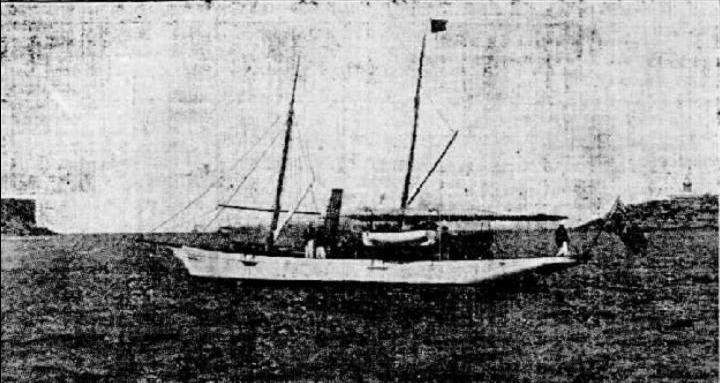
“I sing the sailor of the sail, breed of the oaken heart,” wrote T.F Day in his “songs of the Sea and Sail” and most sailing men will heartily join in the chorus, but steam has played an important part in yachting and cannot be passed over. It is true that with us it has never been a rival to sail. Steam yachts are more expensive to build and to run, and as we have seen, the class of men who could best afford yachting had withdrawn from it before steam yachts became popular elsewhere. Sailing men are apt to become too conservative; they do not care about asking a man on board unless he is used to yachting or boating; and, as a matter of fact, it is penance to some persons to spend an afternoon on board a small sailing vessel. A distinguished .British General, who had been induced to go for a sail on board a 15- tonner, when it was blowing a black nor'-easter, spent an infinitely more uncomfortable couple of hours than ever he had put in under the hottest fire; and a well known artist, whose wit and humor are proverbial, confessed that he was out of place on board a 5-tonner. “The skipper shouted to me to let go the lee runner; I told him he must be mad; I never had such a thing in my hands in my life.”
But onboard a steam yacht, those, who are absolutely ignorant of boats and their ways may not only be entertained, but be entertaining. The fair sex in dainty dresses and with colored parasols look well among the guests and the clergy and the laity may be equally invited. The writer does not mean to infer, that the clergy may not be good sports, but it must be conceded that few of them are such masters of craft as the Rev. Dill Mackay of the Colleen Bawn, and the Rev. J. Cosh, of the Audrey. However, if a clergyman remembers and acts up to the exhortation in Ecclesiastes to 'be not righteous overmuch,' he will be a welcome guest on board most steam yachts, and the writer remembers a very merry trip to the Hawkesbury with a bishop in the party. He was out to make everyone happy; he played a splendid hand at whist, did tricks with cards in which the quickness of the hand deceived the eye, won every game he joined in, forgot his stock when he went to lay the foundation stone of the new church at Wiseman's Ferry, asked for a holiday for the school children instead of asking them goody-goody questions, and was voted the jolliest old sport on board. And why not? Then a steam yacht presents opportunities for flirtation, without the risk of the boom coming across at the supreme moment, and one old steamer-she is still afloat— was the silent witness of many a proposal that would have been made — if made, at all — under infinitely less comfortable conditions on board a small sailing vessel. Those, sweet reader, are the writer's apologies for steam yachts.
SOME STEAM YACHTS
“And above the sullen roar of the breakers on the shore, came the throbbing of the engines as they labored to and fro.” – Paterson.
The Fairy, a beautiful little straight-stemmed screw vessel, with a fair turn of speed, made her appearance in the sixties. She was, perhaps, our earliest steam yacht, but she did not long remain a yacht, and went to earn her living as a ferry boat. In the year 1874, Mr. William Dunn, who has designed and built so many screw steamers, turned out the pretty little Fawn to the order of the late Mr. James Milson, and the same builder built the Ena for Mr. George Cheeke. The second Ena, 56 tons, for Mr T. A. Dibbs; and the Northumbria, 35 tons, for Mr. Christopher Newton, both from the same yard, followed in 1884. The last named yacht was a present to a worthy man from his creditors, in recognition of his determined and successful efforts to pay them in full, after he had obtained a legal release. It will, perhaps, be remembered that Mr. Burt, who left Sydney for Fiji in his 26 ton cutter Vivid, mentioned in a former article, without the usual valedictory banquet, also paid in full the creditors he had left behind him.
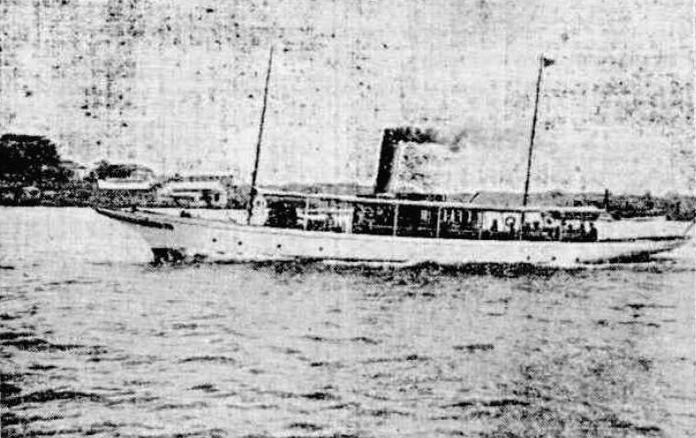
The only other steam yacht of any importance that need be mentioned is the third Ena, 105 tons, designed by Mr. Walter Reeks, and built by Ford in 1901. But the days of the steam yachts are numbered. The benzine boat, (pardon the plagurisim on Mr. Elbert 'Hubbard’s ‘Benzine buggy')is fast usurping her place.
A FAVOURITE CRUISE
A few years back, steam yacht cruises to the Hawkesbury were very common. A plentiful supply of schnappers was picked up off Long Reef; a call was made at Barrenjoey, where dear old Al. Black, the local Collector of Customs, if he could not be induced to join the party, under the pretence that he was to find an illicit still in one of the creeks; was press-ganged on board and the yacht was headed for the glorious scenery of the Hawkesbury. What a delightful cruise up the river; what strange old folk one met; and what pretty girls! No wonder a party of young fellows pushed a heavy fishing boat 40 miles against the current to see some of them. History relates that the girls snubbed those particular Lotharios; but still Hawkesbury lasses are not so coy, and there is a legend that and old sailor, who had gone up the river in search of a wife, found a dashing girl standing bare-headed on the bank without any formal introduction, and with very little preface, he proposed. “Wait ‘til I get my hat” was the lady’s laconic answer.
'But the sea. is wanton, the sea is wilful,
And who shall mend. her and who shall mar. – Gordon
'Duties are ours; events are God's.'
- Cecil.
'How like a queen she walks the summer sea;
Her canvas crowning well the comely mold;
Light joved until it lifts a spire of gold,
Outlined and inset by a tracing of rig and spar.'
— T. F. Day.
CRUISING AND CLASS RACING.
A man who goes yachting will meet with more men. of a different class from his . own than he would at cricket, golf, or tennis; and it is' not one of the least charms of cruising to meet those who gain their livelihood on the salt water. They have all their story— the story that is stranger than fiction, though they may not think it worth the telling. What glorious sunrises and sunsets they have seen! What dreamy runs down the coast before the nor'-easter, and what wild dashes, up before the southerly they have made! What battles with wind and wave they have fought! Some of our coasting sailors are bushmen too. One the writer remembers was even a steeplechase rider; another, went into he bush and felled the hardwood for the cutter he built and sails. He launched her on her side full quarter of a mile over gum-saplings, with a horse hitched on to the stern-post. Some cut firewood or crooks, and bring them to town in their home-made ketches, whilst others, it is said, do a bit of smuggling, and the firewood above is but a cover for the firewater below.
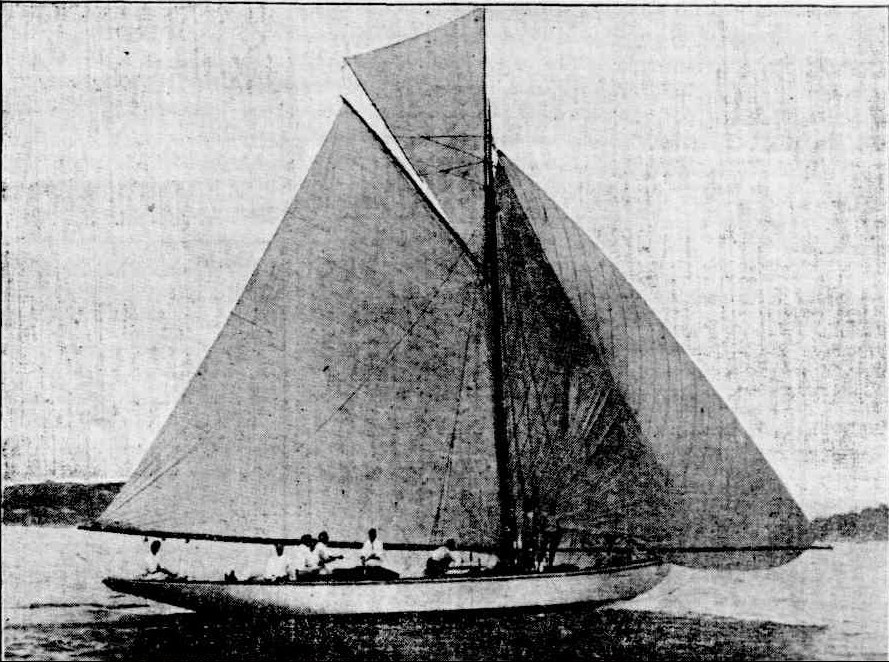
Gentle reader, have you ever moored your boat on steamer night under the beetling cliffs of that weird, black headland, Barrenjoey? Three hundred feet above is the deep red light, that has guided many a storm-tossed craft to a haven of refuge; below the flares-up of the Italian fisherman, busy packing their crayfish for the market, are reflected in patches of gold on the ink-like water; and out in the bay the riding lights of several smaller traders' burn dimly. The Italians are not by any means the Italians of opera or comic opera and they are too busy to even sell you a crayfish. Some of the traders are waiting to tranship their produce to the steamer: another, laden with firewood, is weather-bound. You strike up acquaintance with the old fellow on board. He comes alongside In his rattle-trap of a dingey, and accepts a glass of your excellent whisky; he drinks it neat, followed by a mouthful of water, and confides to you that you can get a really good drop of stuff at some impossible public-house in the purlieus of Pyrmont or Darling Harbor side. He hesitates about coming on board but, eventually you hook him. His troubles are, of course, uppermost in his mind, and he tells you of half a dozen vain attempts to reach Sydney with his bit of fire wood, but he is going to make an early start on the morrow, so as to make the port before the morning westerly veers round to the south. He is all alone on board his little craft; and loaded as she is, he can't flog her against a head wind and sea. He used to have a 'nipper' on board a former boat, but when she was run down one night by a steamer the 'nipper' was lost, and he has never got another. He has seen some wild nights outside, but what he is afraid of is the steamers.
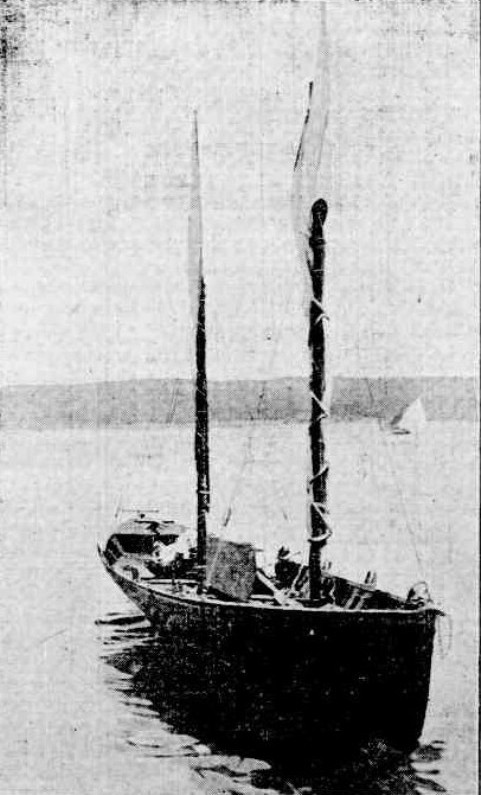 A DRAMA BETWEEN THE HEADS.
A DRAMA BETWEEN THE HEADS. About 8 o’clock the ship Strathdon, from London was sighted close to the Heads, and Pilot Robinson and his crew put off to bring her in. About the same time a butcher-boat with Robert Green in charge was making for the ship. There was in those days the keenest competition for orders, and many a stirring race took place between the rival butcher-boats, whose Crews were picked from our best professional scullers. Midway between South Reef and the Old Man's Hat the pilot boat was struck by a sea and capsized. Green promptly, went to the rescue in his swift, lightly-built boat, which was manifestly unequal to the increased weight of the rescued crew, and she was almost immediately swamped. Two pilot boats under charge of Pilots Jenkins and Shanks were then despatched to the scene; the latter’s boat was overturned, and to Pilot Jenkins was left the dangerous and difficult task of attempting to save the three boats crews. He did his work well, and succeeded in landing at Manly as many as his boat could carry. Robert Green, the master of the row-boat, observed the etiquette of the occasion as punctiliously as if he had been the captain of a battleship; he insisted on his men saving themselves, and then refused to add his weight to the overladen pilot boat. Pilot Jenkins returned from Manly, and, with a number of villagers and fishermen, from Watson's Bay who had put off in their boats, resumed the now hopeless search. The sound of mourning— the mourning of the widows and the fatherless— was heard in the little village; eight of the men, including Robert Green and Pilots Robinson and Reeder, had played their last part.
The old fellow is away before dawn next morning, slowly sweeping his crazy old craft out with the tide, while you, gentle reader are sleeping in your cosy cabin. You pass him off the Hole in the Wall, and he waves his hand to you; you are pleased at his kindly recognition. He is one of our toilers of the sea, a class that the people of Sydney should indeed be proud of. But as old Sanger, the circus proprietor used to say, 'Let's cut the cackle, and come to the 'osses.''
AN AMERICAN YACHT'S VICTORY.
The J. S. Poyen, Junior, was built in New York, in the eighties, for racing purposes, on Lake Erie, and was shipped to Sydney to Mr. Jewett, who afterwards owned the Langford built Mabel. The Poyen was a beamy centre boarder, and carried a big spread of canvas. Her appearance here created a great deal of interest, and she is said to have been the only American yacht that has raced in our waters. Her best performance was in a race to Wollongong and back that Dr. Milford was responsible for. One condition was that each competitor should tow a dingey, which, as may be imagined, caused trouble. The Poyen, Assegai, Sao, and Water Nymph were started from Farm Cove about dusk one Friday. A big sea was running outside, and the Sao, having carried away her bowsprit, returned to port. The. Assegai lost her dingey off Botany but her owner continued the race, expecting that the other boats would meet with a similar experience. She was the first to round the mark off Wollongong about dawn. The Water Nymph overran the mark, and brought up off Kiama. So far it had been a run before a nor'-easter, which increased in strength as the day wore on. The Assegai had the best of the beat up the coast, but the wind left her off Botany, and she rolled and pitched in the heavy sea for a couple of hours. The owner deemed it prudent to replace his racing sails with a trysail in view of a coming southerly, which brought the Poyen up to her, and they both reached South Reef together, where the wind again failed. It was in the early hours of Sunday morning that the Assegai finished first, with the Poyen a close second; but the latter had her dingey still in tow, and was awarded he prize. There seems to be no reliable report of the race in print, and those who were on board the yachts give rather different accounts of the race, due no doubt to the night work, and the fact that they saw very little of each other during the day. The Poyen was not a successful boat in other matches, and she was eventually taken to Brisbane, where, after having been washed into the Botanic Gardens during a flood, she became an oyster boat.
CLASS AND OTHER RACING.
Port Jackson has not had until recent years very much class racing between yachts. Among the 40-tonners, the Era, after the departure of the Volunteer for Auckland, was left without a rival, for the Miranda was no match for her, and, with the exception of the two and a half and the five-ton class, the racing boats of the nineties were 'odd lengths.' Still, the sport was kept going. Nothing was too big or too small; nothing too fast or too slow. They all came to the scratch, and trusted to the handicapper to do the levelling up and levelling down. Thus we find in one of the R.S.Y.S. races in 1893 the Thelma, 15-rating, scr; Archina 13- rating, 14min; Isea, 9.97-rating 17min; Assegai, 7.4-rating, 21min; Bronzewing, 2 ½ rating, 27min; Lahloo, 6- rating, 35min; whilst the P.A.Y.C had an equally varied assortment of yachts racing about the same time. It speaks well for the sportsmanship of owners, whether of fast or slow boats, that they started under such conditions, and the variety of size, shape, and rig was not without its charm from an onlooker's point of view; but it was extremely unsatisfactory racing, and the poor handicapper must have felt his ears burn very often.
THE THELMA AND OTHER YACHTS.
The Thelma was the best of the bunch. She had been built by George Ellis to Mr. Reeks' designs, and for model, build, and good taste was all anybody could wish for. Both her former owner, Mr. J. F. Hoare, and her present. Dr. MacCormick, scored many wins in her, and although she has been relegated to the cruiser class, she has still a wide circle of admirers, some of whom are sufficiently infatuated to contend that, if she were only tuned up, she could bring home the Sayonara Cup. The Archina, yawl, was built by Dudley. She was a better cruiser than a racer, and visited both the Derwent and Port Phillip. The Bronzewing, one of Mr. Sam Hordern's many boats, like her principal rival, the Bul Bul, was of British design, and those two boats are responsible for breaking up the racing of the local class of 'twofers,' which had been built under a different rule. The Iolanthe was imported from Scotland, and her many contests against the Sao, the Assegai, and, later, the Herreschoff, all about the same size, were particularly interesting. Mr. Cameron's Iduna, 28 tons, was a fine comfortable cruiser, with a turn of speed.
A ROUGH DAY.
One of the best races she ever sailed was against the Thelma, in 1895. That day fifty men were rescued in the harbor by the Water Police. The Manly boats had to cease running; and the big seas sent showers of spray above the Gap. The Iduna was 1min 5sec ahead at the Manly buoy, and though at one time on the beat back, the Thelma crossed her, she eventually passed the flagboat, when the commodore of the day stopped the race, some 4min ahead. In the 1897 race for the Gascoigne Cup the Thelma was successful against the Iduna, Oithona, Isea, Iolanthe, and Herreschoff; and in the same year we find the yawl Electra beating the Iduna and the Archina similarly rigged. But the many races about this time were really shuffles of the same old pack.
SOME INTERCOLONIAL RACES.
The sending of the Bronzewing to Hobson's Bay in 1893 to meet bigger boats was a departure from the beaten track; she took third place, and her handicap was not sufficient to help her. Then Mr. Pittar brought the speedy Meteor from Auckland, and the Bronzewing was again beaten; but the boats were of different sizes, and neither rating allowances nor clocks can ever give the satisfaction of one class racing. Towards the end of the nineties several new names appeared amongst the racing yachts, of which Mr. Sam Hordern's Whitewings, a fine centreboarder from an imported design, was easily the best, and the end of the decade saw the coming of the thirty footers, which the Meteor had heralded. No class of yacht has given us better sport than she and her successors from Auckland, together with the English and Scotch designed boats of the same class, have provided us with during the last seven years. As many as ten thirty-footers have started in a race.
Those who take an interest in yachting here are indebted to Mr. Pittar for bringing to Sydney the Meteor and Sunbeam, both thirty footers, and the 40-raters Rainbow and Rawhiti. It is to be regretted that so enthusiastic a yachtsman did not receive more encouragement. It is very improbable that he will bring another yacht to Port Jackson. In January, of 1905 the Sayonara sailed into Port Jackson from Hobson's Bay to meet the 40-rater Bona, in a series of three matches, in two of which she was successful, and she took back with her the Sayonara Cup which she recently successfully defended against the Rawhiti, and may again have to do battle for against the 10-metre Awanui, built by Ford, from lines by Fife.
(To be Continued.)
PORT JACKSON'S PLEASURE FLEETS. (1907, November 30). Evening News (Sydney, NSW : 1869 - 1931), p. 11. Retrieved from http://nla.gov.au/nla.news-article113900099
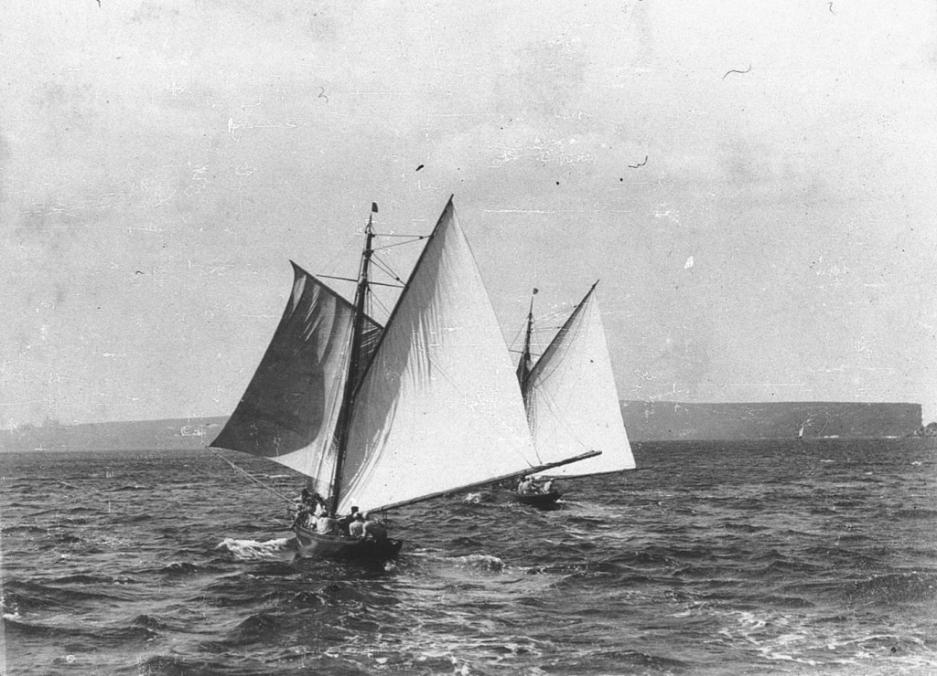
"Sao" and "Iolanthe" in second event of Sweepstake Race. Prince Alfred Yacht Club - Sydney, NSW - March 1888, image no.: bcp02002h, courtesy State Library of NSW.
Extras:
SAILORS - HOME PICNIC
The members of the Royal Sydney and Prince Alfred YACHT SQUADRONS have kindly consented to co-operate by making Tuesday a squadron day. The splendid BANDS of the Galatea and Queen's Own Regiment will be in attendance. Applications for tickets will be received by the Secretary, Treasurer, or any member of the committee. Tickets may also be obtained at the Exchange, Sands and Co.'s, Anderson V, Elvy and Co.'s, Moffitt's, Reading, and Swellbank's, and at Mitchell's, Circular Quay.
FRANCIS HIXSON, Hon. Secretary.
BENJAMIN BUCHANAN, Hon. Treasurer.
N. B. - Early application for tickets is positively necessary.
Advertising. (1868, February 14). The Sydney Morning Herald(NSW : 1842 - 1954), p. 8. Retrieved from http://nla.gov.au/nla.news-article13160773
WISEMAN'S FERRY. Dr. Barry, the Primate, who at present is the guest of Mr. T. A. Dibbs, on board the commodious yacht, Ena, visited Wiseman's Ferry on Tuesday. He took an interest in seeing a start made in there-building of the church, which a year ago, when in ruins, was taken down by the Roads Department, it being partially on the Government road.
Amongst those who assembled to meet the Bishop were, Mr. Henry Wilson, J. P., of Rivers Vale, and Messrs. James Walmsley, sen. and jun., H. A. Wilson, Alex. Byven, and Thos. Rose. Dr. Barry inspected the site for the new church, and after making a promise that it should be built without any further delay, on what he considers one of the most picturesque parts of the Hawkesbury, he embarked and proceeded on to Colo, where the party camped that night. As the Primate was leaving the jetty three hearty cheers were given for him. WISEMAN'S FERRY. (1889, March 2). Windsor and Richmond Gazette (NSW : 1888 - 1954), p. 5. Retrieved from http://nla.gov.au/nla.news-article72558896
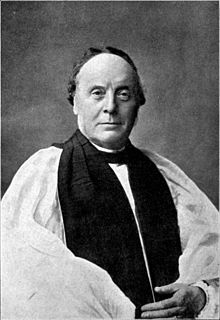 Dr. Alfred Barry (15 January 1826 – 1 April 1910) was the Third Bishop of
Sydney, who over the course of his career served as headmaster of several
independent schools, Principal of King's College London, and founded several
prominent Anglican schools. He was the son of Charles and Sarah Barry, and had
four brothers; Charles Barry (junior), Edward Middleton Barry, John Wolfe-Barry
and Godfrey Barry. From King's College
School, he went to Trinity College, Cambridge (B.A., 1848; M.A., 1851), where
his performance as 4th Wrangler (aeq.) and 7th Classic won him a minor
fellowship and a Smith's prize.[2] In 1850 he became a major fellow and was made
deacon by Bishop Thomas Turton of Ely; Bishop Wilberforce of Oxford ordained him
priest in 1853. He continued with divinity studies (B.D., 1860; D.D., 1866).
Oxford gave him an honorary D.C.L. in 1870, as did Durham in 1888.
Dr. Alfred Barry (15 January 1826 – 1 April 1910) was the Third Bishop of
Sydney, who over the course of his career served as headmaster of several
independent schools, Principal of King's College London, and founded several
prominent Anglican schools. He was the son of Charles and Sarah Barry, and had
four brothers; Charles Barry (junior), Edward Middleton Barry, John Wolfe-Barry
and Godfrey Barry. From King's College
School, he went to Trinity College, Cambridge (B.A., 1848; M.A., 1851), where
his performance as 4th Wrangler (aeq.) and 7th Classic won him a minor
fellowship and a Smith's prize.[2] In 1850 he became a major fellow and was made
deacon by Bishop Thomas Turton of Ely; Bishop Wilberforce of Oxford ordained him
priest in 1853. He continued with divinity studies (B.D., 1860; D.D., 1866).
Oxford gave him an honorary D.C.L. in 1870, as did Durham in 1888.
He was consecrated in Westminster Abbey on 1 January 1884 by the Archbishop of Canterbury, assisted by the Bishops of London, Durham, Lincoln, Rochester, Dover and Bishop Perry. On 24 April, he was enthroned in St. Andrew's Cathedral, Sydney, installed as Bishop of Sydney and recognized as metropolitan of New South Wales and primate of the Church of England in Australia and Tasmania.
In 1891 he was appointed Canon of the eleventh stall at St George's Chapel, Windsor Castle, a position he held until 1910. He died at Windsor and was buried in Worcester Cathedral. He was survived by his wife Louisa Victoria, daughter of Canon Hughes of Peterborough, whom he had married on 13 August 1851, and by two sons and a daughter.
Right Rev. Alfred Barry, D.D. - Distinguished Churchmen, photograph by Elliott and Fry.
Alfred Barry. (2014, June 16). In Wikipedia, The Free Encyclopedia. Retrieved from http://en.wikipedia.org/w/index.php?title=Alfred_Barry&oldid=613140723
NEW METHODIST CHURCH AT ST. ALBANS. WISEMAN'S FERRY, Saturday.
On Thursday the new Methodist Church at St. Albans was opened free of debt. Mrs. A Walker, of St. Albans, wife of Mr. A. Walker, J.P., using a silver key, the gift of the Rev. J and Mrs. Colwell, of Sackville Reach, declared the church open. There was a debt of £44, but that was wiped out by freewill offerings from £2 downwards. When the last pound was handed in the whole congregation rose and sang the Doxology. Three steam launches were engaged, viz., the Surprise, the Express, and the Union to convey people from all parts of the Hawkesbury, as far as navigable water would allow them to go. Thus some who carne by the last boat, owing to the low tide, had to walk nearly six miles though a number of conveyances were plying between St. Albans and the boats. There must have been fully 400 people on the church grounds in the afternoon and evening, The building is an ornament to the town. The cost was £400. Messrs. Arnold Brothers were the contractors, and the architect was Mr. S. Rigg. The church is built of stone, with rock-faced dressings, the ceding is of varnished kauri ; a superior style of seats, also of kauri, whilst the pulpit and rostrum aie of kauri, with cedar panels, and the windows of tinted cathedral glass. In addition to raising the £11 to clear off the debt on the building and furniture, the net proceeds of the tea meeting, amounting to £26, were given to the circuit funds. Thus financially this gathering was a great success.
The Rev. W. G. Taylor, of the York-street Church, Sydney, preached the dedicatory sermon to an overflowing congregation. Mr M. B. Herps, J.P , was the chairman at the evening service, when addresses were delivered by the Revs. W. G. Taylor and J. Colwell. NEW METHODIST CHURCH AT ST. ALBANS. (1902, February 24). The Sydney Morning Herald (NSW : 1842 - 1954), p. 5. Retrieved from http://nla.gov.au/nla.news-article14456448
Of the various Enas, the first was built for Mr. George Cheeke, the other two for Sir Thomas Allwright Dibbs and named after his wife Tryphena. Mr Dibbs was a brother of New South Wales Premier Sir George Dibbs, a keen yachtsman and commodore of the Royal Sydney Yacht Squadron for a while. Devout in nature, active in diocesan affairs of the Church of England, his philanthropic interests included the Sydney Naval Home and the Queen Victoria Home for Consumptives. In June 1915 he gave his home, Graythwaite, to the Commonwealth government as a convalescent hospital for wounded soldiers. (1.) He attracted the envy of some and admiration of a greater number.
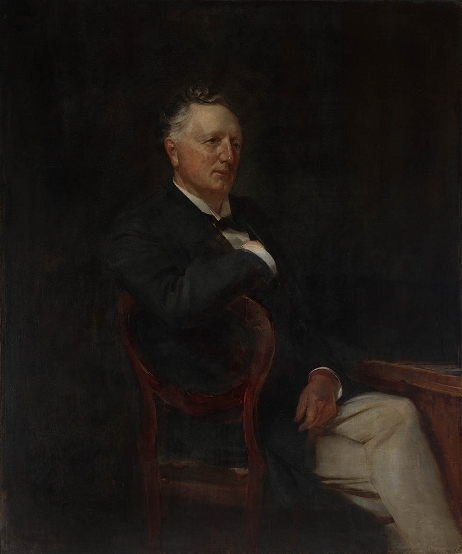 DEATH OF SIR T. A. DIBBS. Notable Australian Banker.
SYDNEY, Sunday-The death occurred this morning, at his residence, Wolseley road,
Point Piper, of Sir Thomas Allwright Dibbs. He was in his 91st year and had been
ill for about three weeks. The death of Sir Thomas Dibbs marks the passing of
one of Australia's most notable bankers and one whose munificent spirit and
public service had been identified with so many benevolent and patriotic
movements. The spirit of public service exemplified in many directions by Sir
Thomas Dibbs was strikingly manifested by him in co operation with Lady Dibbs in
the gift to the authorities of his beautiful home, Graythwaite, North Sydney as
a home for disabled soldiers. Sir Thomas Dibbs, who was a son of Captain John
Dibbs, of St Andrews, Scotland, and who was educated at the Australian College,
Jamieson Street, Sydney, had knighthood conferred upon him in 1917, and of the
honours then conferred by the King, none gave more general satisfaction than
that bestowed upon the veteran banker and philanthropist. His name will always
be associated with the Commercial Banking Company of Sydney, from which he
retired in 1915, after 68 years' service, taking a seat on the board of
directors on his retirement. Of his long service with the company 48 years were
spent as general manager. Sir Thomas Dibbs is survived by Lady Dibbs, who is
aged 83 years. Mr Tom Burton Dibbs, the only son, died in Geelong about two
years ago. A daughter, Mrs Charlie Gaden, is also dead. Members of the family
who are living are Miss Dibbs, Mrs H H Massie, Mrs. Fred Cape, Mrs T Honnor
(England), Mrs W Mitchell, and Mrs W Ritchie, of New Zealand. Mrs Burton Dibbs
arrived in Sydney from Geelong on Saturday. DEATH OF SIR T. A. DIBBS.
(1923, March 19). The Argus(Melbourne, Vic. : 1848 -
1957), p. 10. Retrieved from http://nla.gov.au/nla.news-article1883838
DEATH OF SIR T. A. DIBBS. Notable Australian Banker.
SYDNEY, Sunday-The death occurred this morning, at his residence, Wolseley road,
Point Piper, of Sir Thomas Allwright Dibbs. He was in his 91st year and had been
ill for about three weeks. The death of Sir Thomas Dibbs marks the passing of
one of Australia's most notable bankers and one whose munificent spirit and
public service had been identified with so many benevolent and patriotic
movements. The spirit of public service exemplified in many directions by Sir
Thomas Dibbs was strikingly manifested by him in co operation with Lady Dibbs in
the gift to the authorities of his beautiful home, Graythwaite, North Sydney as
a home for disabled soldiers. Sir Thomas Dibbs, who was a son of Captain John
Dibbs, of St Andrews, Scotland, and who was educated at the Australian College,
Jamieson Street, Sydney, had knighthood conferred upon him in 1917, and of the
honours then conferred by the King, none gave more general satisfaction than
that bestowed upon the veteran banker and philanthropist. His name will always
be associated with the Commercial Banking Company of Sydney, from which he
retired in 1915, after 68 years' service, taking a seat on the board of
directors on his retirement. Of his long service with the company 48 years were
spent as general manager. Sir Thomas Dibbs is survived by Lady Dibbs, who is
aged 83 years. Mr Tom Burton Dibbs, the only son, died in Geelong about two
years ago. A daughter, Mrs Charlie Gaden, is also dead. Members of the family
who are living are Miss Dibbs, Mrs H H Massie, Mrs. Fred Cape, Mrs T Honnor
(England), Mrs W Mitchell, and Mrs W Ritchie, of New Zealand. Mrs Burton Dibbs
arrived in Sydney from Geelong on Saturday. DEATH OF SIR T. A. DIBBS.
(1923, March 19). The Argus(Melbourne, Vic. : 1848 -
1957), p. 10. Retrieved from http://nla.gov.au/nla.news-article1883838
Above: Portrait of Sir Thomas Allwright Dibbs, 1897 / painted by Tom Roberts. A plaque originally at lower centre read "Presented to Thomas Allwright Dibbs General Manager of the Commercial Banking Company of Sydney Ltd. By The Officers of the Bank in Commemoration of the Completion of his Fiftieth year of Service in the Institution 7th July 1897" Formerly hung at Graythwaite, home of Sir Thomas and Lady Dibbs until 1915, when it became a nursing home. Album ID : 874522, courtesy State Library of NSW.
SAILING. The Royal Sydney Yacht Squadron will celebrate the opening of its new club house, at Kirribilli Point, on Saturday next, by inviting the commodore (Mr. T. A. Dibbs) to a garden party, which will be preceded by a rendezvous in Neutral Bay oi all the club yachts. The race for next Saturday has consequently been postponed. SAILING. (1903, January 17). Evening News (Sydney, NSW : 1869 - 1931), p. 2. Retrieved from http://nla.gov.au/nla.news-article113403857
AQUATICS. EASTER CRUISE. The fine weather is evidently inducing a huge number of " campers-out " this year than hitherto. During yesterday evening numbers of craft, from the stately yacht to the miniature canvas dingy, could be seen making their way down the harbour to the various nooks and corners which abound in Middle Harbour, North Harbour, Vaucluse, &c. Several of the larger yachts, including the White Star, Ena, Iduna, Thelma, and Ess, got under weigh yesterday. The Ises and others will follow during the morning, all bound for Broken Bay. Refuge Bay and the Basin will no doubt be the favoured spots chosen by the yachtsmen. The steam yacht Isis will no doubt be in evidence, her favourite spot being Evening Bay, on the eastern shores of Pittwater. The Ena will no doubt be found in Coal and Candle Creek, a tributary of Cowan. Apparently there is plenty of fishing to be had according to report, so that the next few days, provided it remains fine, should be spent very pleasantly. AQUATICS. (1896, April 3). The Sydney Morning Herald (NSW : 1842 - 1954), p. 3. Retrieved from http://nla.gov.au/nla.news-article14044107
MR. T. A. DIBBS. Mr. Thomas Allwright Dibbs, general manager of the Commercial Banking Company of Sydney, has to-day reached his 60th year of active service in the bank. He entered the bank as a junior clerk, and worked his way up to the position of manager, which he has held for over 40 years. When he became manager the bank's business amounted to £2,332,000; and when the jubilee of his connection with the institution took place 10 years ago, it had increased to £12,261,000. At the present time it is still better. Mr. Dibbs, is a brother of the late Sir George Dibbs and is now 74 or 75years of age. MR. T. A. DIBBS. (1907, July 6). Evening News (Sydney, NSW : 1869 - 1931), p. 9. Retrieved from http://nla.gov.au/nla.news-article112644479
MR. T. A. DIBBS' PHILANTHROPY. Handsome donations have recently been made to various hospitals and philanthropic institutions by Mr. T. A. Dibbs, general manager of the Commercial Banking Company of Sydney. Mr. Dibbs, whose acts of charity are well known, believes that it is the duty of a citizen to carryout philanthropic work during his lifetime, and not to allow the whole of such gifts to be made after his death, and it is that others may contribute in the same way that he has recently donated to charities something like £10,000.
He has set apart £5000 to establish a fund for the relief of sickness and distress arising from time to time among the officers of the. Commercial Banking Company. The sum of £1000 has been given by Mr. Dibbs to the North Shore Hospital; to the Home for Incurables, the Children's Hospital, and the Consumptives Home, Wentworth Falls, he has given £1000each; to the Nurses' Home, £350; to the chapel building fund, Church of England Grammar School. £350, and other sums to various other institutions. MR. T. A. DIBBS' PHILANTHROPY. (1909, January 18). Evening News (Sydney, NSW : 1869 - 1931), p. 3. Retrieved from http://nla.gov.au/nla.news-article113342746
Notable Australian T. A. Dibbs. The record put up by Mr. T.A. Dibbs, the retiring manager of the Commercial Bank of Sydney, is a remarkable one, and of immense credit to New South Wales commercial and national life. As to the man himself, the striking point of this remarkable record is its personal feature, of a clear running river of ability, honor and energy. Tom Dibbs has been a big man in a noted family of big, fine-type men, worthy a front place among the best of any country. They have always been straight, big minded Australians. George Dibbs, a brother, was as clean and big-hearted an Australian as ever stood in politics in this country. Tom Dibbs' personal record is this. He lived in the glare of public light all his life, and retires now in a glow of universal respect and regard. Notable Australian T. A. Dibbs. (1915, July 24). The Newsletter: an Australian Paper for Australian People (Sydney, NSW : 1900 - 1918), p. 4. Retrieved from http://nla.gov.au/nla.news-article112708771
LATE SIR T. A. DIBBS. Probate has been granted of the will of the late Sir Thomas Allwright Dibbs, of Graythwaite, Point Piper, Woollahra, who died on March 18 last, leaving an estate of the net value of £133,680, of which £86,140 represented shares in public companies and £19,702 Government stock. The testator appointed Mr. Hugh Hamon Massie, general manager of the Commercial Banking Co. of Sydney, Ltd., and the Perpetual Trustee Co., Ltd, executors and trustees of his estate. LATE SIR T. A. DIBBS. (1923, April 25). The Sydney Morning Herald (NSW : 1842 - 1954), p. 8. Retrieved from http://nla.gov.au/nla.news-article16077454
Sir Samuel Hordern. NEW YEAR HONOR
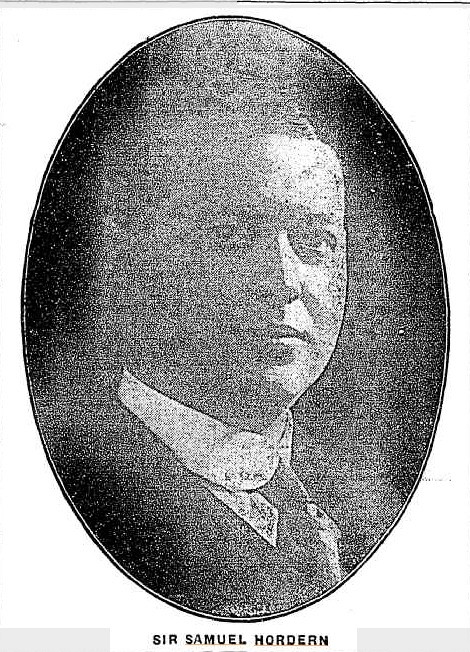 It is Sir Samuel Hordern now ! The Knighthood came with the
New Year. And the congratulations are pouring in from all over Australia. As
businessman, live stock breeder, sportsman, and all-round good man, Sir Samuel
Hordern is known in every State, and is popular everywhere. He is one of the
owners of one of the finest businesses in the Southern Hemisphere ; he is the
owner of some of the best Jersey cattle; he is the owner of some of our best
racehorses —including Arch Marella. And he is the owner of some great pigeons!
Yes, he is an all-rounder. As president of the Royal Agricultural Society, Sir
Samuel Hordern comes in contact with a large number of our primary producers.
Besides, isn't he one of them with his stud farms at Bowral and Wingen! He is
doing his bit for the great primary industries, as well as being a captain in
the secondary interests. His is a life full of useful activities. Born at
Darling' Point, 42 years ago Sir Samuel was educated at the Sydney Grammar
School, and afterwards at Bath College, England. He married Miss Lottie See, the
eldest daughter of the late Sir John See, at one time Premier of the State; and
the next generation of Horderns include two daughters — Doreen and Audrey — and
one son, Sam. He lives at Darling Point, in a beautiful home, whose furnishings
are practically all Australian. He is an enthusiast in the breeding of stock. He
is president of the Royal Agricultural Society, having been elected in 1915 by a
majority of four to one in succession to the late Sir Francis Suttor, and he has
held office ever since. He was previously a vice-president and a prominent
member of the council, and has always taken a whole-hearted interest in the
development of the society. He is a member of the board of directors of the A.M.
P. Society, and of the Royal Insurance Society. He is a member of the council of
the Chamber of Commerce, and a member of the committee of the Australian Jockey
Club. He is ex- president of the Master Retailers' Association. He is president
of the Automobile Club, he is hon. treasurer of the Royal Prince Alfred
Hospital, a member of the council controlling the Lord Mayor's Patriotic Fund,
and a member of the Board of Repatriation. He is the youngest Knight in the
Commonwealth, excepting Sir Douglas Mawson. His ambition in life is to do
something, the best he can, for the State in which he has been born. The State
wishes him Good Luck! SIR SAMUEL HORDERN.
Sir Samuel Hordern. (1919, January 3). The Sydney Stock and Station
Journal (NSW : 1896 - 1924), p. 13. Retrieved from http://nla.gov.au/nla.news-article124350130
It is Sir Samuel Hordern now ! The Knighthood came with the
New Year. And the congratulations are pouring in from all over Australia. As
businessman, live stock breeder, sportsman, and all-round good man, Sir Samuel
Hordern is known in every State, and is popular everywhere. He is one of the
owners of one of the finest businesses in the Southern Hemisphere ; he is the
owner of some of the best Jersey cattle; he is the owner of some of our best
racehorses —including Arch Marella. And he is the owner of some great pigeons!
Yes, he is an all-rounder. As president of the Royal Agricultural Society, Sir
Samuel Hordern comes in contact with a large number of our primary producers.
Besides, isn't he one of them with his stud farms at Bowral and Wingen! He is
doing his bit for the great primary industries, as well as being a captain in
the secondary interests. His is a life full of useful activities. Born at
Darling' Point, 42 years ago Sir Samuel was educated at the Sydney Grammar
School, and afterwards at Bath College, England. He married Miss Lottie See, the
eldest daughter of the late Sir John See, at one time Premier of the State; and
the next generation of Horderns include two daughters — Doreen and Audrey — and
one son, Sam. He lives at Darling Point, in a beautiful home, whose furnishings
are practically all Australian. He is an enthusiast in the breeding of stock. He
is president of the Royal Agricultural Society, having been elected in 1915 by a
majority of four to one in succession to the late Sir Francis Suttor, and he has
held office ever since. He was previously a vice-president and a prominent
member of the council, and has always taken a whole-hearted interest in the
development of the society. He is a member of the board of directors of the A.M.
P. Society, and of the Royal Insurance Society. He is a member of the council of
the Chamber of Commerce, and a member of the committee of the Australian Jockey
Club. He is ex- president of the Master Retailers' Association. He is president
of the Automobile Club, he is hon. treasurer of the Royal Prince Alfred
Hospital, a member of the council controlling the Lord Mayor's Patriotic Fund,
and a member of the Board of Repatriation. He is the youngest Knight in the
Commonwealth, excepting Sir Douglas Mawson. His ambition in life is to do
something, the best he can, for the State in which he has been born. The State
wishes him Good Luck! SIR SAMUEL HORDERN.
Sir Samuel Hordern. (1919, January 3). The Sydney Stock and Station
Journal (NSW : 1896 - 1924), p. 13. Retrieved from http://nla.gov.au/nla.news-article124350130
At the invitation of Mr. S. Hordern, Commodore of the Prince Alfred Yacht Club, some sixty of the members of the club and their friends — included in the latter being .representatives of New Zealand and South Australian clubs — assembled in the handsome billiard-room of Retford Hall, Darling Point, on Wednesday night last, where a most enjoyable smoke concert was given. The spacious room was tastefully decorated for the occasion with bunting, whilst emblems of the sport wore to be found in the costly array of prettily disposed models, which were objects of much interest. Ex-Y.C. Griffiths, on whom the management devolved, improvised an excellent programme, and assisted in no small measure to the success of the evening. After Mr. DeGroen's pleasing pianoforte prelude, Mr.Brown, with nautical emphasis, Being Here Upon My Vessel's Deck,' and Mr. Lindsay, whose acceptable numbers throughout found special favor, notwithstanding ttso orthodox cold, selected ' Love is Blind ' and ' Sally Horner,' both of which were rendered in true artistic style. Mr. O'Eagan, the possessor of a powerful bass of limited compass, gave spirited interpretations of ''Thy Sentinel am1 ' and ' Out on the Deep,' a unanimous encore following each. Mr. Dalton, who cansing as well as he can give a bugle call, contributed ' A Son of Mars ' and The King's Minstrel ' with irresistible vigor. Mr. Stent, of the Sydney Banjo Club, showed great power as an executant of this attractive instrument, and delighted his audience with a miscellany of gems given with the dash and precision indispensable to effect, and Mr. Andrews in histwo cornet solos, ' Adelaide ' and 'Alice,' was cordially received. Vice-Commodore P.H Sullivan displayed good vocalisation in' Come Where My Love Lies Dreaming,' marred by a distinctly distasteful chorus, and Messrs. Allen, Griffiths, and Eoss also placed their efforts at the disposal of the company. Fair anchorage was found in the refreshment room; where liberal provision had been made for creature comfort, the popular host being indefatigable in his efforts to make all at home. Votes of thanks were accorded Mr. DeGroen for accompanying, and the artists who so kindly lent their services, whilst brief response was made by the Commodore and Mr.Griffiths to the toasts of their healths, given with musical honors. The company separated about 11.30, special arrangements having been made for their conveyance home. SOCIAL ITEMS ENGAGEMENTS. NOVEMBER. (1895, November 3). Sunday Times (Sydney, NSW : 1895 - 1930), p. 8. Retrieved from http://nla.gov.au/nla.news-article130407387
Hordern, Sir Samuel (1876–1956). Sir Samuel Hordern, the senior member of one of Australia's most prominent pioneer families, died at his Darling Point, Sydney, home on 3rd June at the age of 79. He had been a semi-invalid for some years, as the result of an accident at his Retford Park property, near Bowral, N.S.W., and at the time of his death had resigned from the many company, charitable, and educational boards with which he had been connected for many years.
He was educated at Sydney Grammar School and Bath College, England, and then joined the family retail firm of Anthony Hordern and Sons, which had been founded by his grandfather, who married a granddaughter of the Reverend Samuel Marsden, the Colony's first senior chaplain and one of the founders of the sheep industry in Australia. Sir Samuel assumed control of the business on the death of his father, Mr. Samuel Hordern, in 1909 and became governing director when it was formed into a private company in 1912. He retired from the company in 1926 when it was sold to public investors, but continued to direct many other organisations. He was a former chairman of the A.M.P. Society, and Royal Prince Alfred Hospital, and a former director of the Perpetual Trustee Company of N.S.W., the Commonwealth Bank Board, and the Royal Insurance Company.
Like other members of his family, Sir Samuel was keenly interested in the primary industries and devoted much of his time to the affairs of the Royal Agricultural Society of N.S.W. He followed his father as a councillor of the society and was himself president for 26 years, from 1915 to 1941, during which period great expansion took place. His brother, Mr. Anthony Hordern, of Milton Park and Mungadal, has also been a councillor for many years, whilst his son, Mr. Samuel Hordern, has been president for the past two years. For his work with the R.A.S. Sir Samuel was created a Knight Bachelor in 1919, and received the honour of K.B.E. in 1938.
As a further contribution to the primary industries Sir Samuel developed Retford Park into a noted stud stock property, and in particular bred some of the best Jersey cattle in the State. He was also a keen racing man and for a time was acting chairman of the Australian Jockey Club. His horses won many important races, including the A.J.C. Derby and Melbourne Cup (Artilleryman) and Caulfield Cup (Violoncello).
In 1900 Sir Samuel Hordern married Miss Charlotte See, eldest daughter of Sir John See, who represented Grafton in the N.S.W. State Parliament from 1880 to 1904, and was Premier from 1901 to 1904. Lady Hordern died in 1952, but he is survived by his son and two daughters, Mrs. Oscar M. Peall and Mrs. William A. Winter-Irving.Pastoral Review and Graziers' Record, 16 June 1956, p 753
At St Jude's Anglican Church, Randwick, on 4 March 1900, he had married Charlotte Isabel Annie (d.1952), daughter of (Sir) John See. They lived at Strathfield and later bought Mount Adelaide at Darling Point, which was demolished to build Babworth House in 1912; designed by Morrow and De Peutron, it was considered the finest Art Nouveau house in Sydney. Hordern belonged to the Union, Australian, Warrigal and New South Wales clubs, played golf at Concord and Royal Sydney Golf clubs and sailed with the Royal Sydney Yacht Squadron and Royal Prince Alfred Yacht Club. He was an early member of the (Royal) Automobile Club and president in 1910-12 and 1914-30. Caroline Simpson, 'Hordern, Sir Samuel (1876–1956)', Australian Dictionary of Biography, National Centre of Biography, Australian National University, http://adb.anu.edu.au/biography/hordern-sir-samuel-506/text11627, published in hardcopy 1983
The Prince Alfred Yacht Club. A number of gentlemen interested in aquatics, and owning sailing boats, met at Messrs.. M'Grath and Punch's Hotel, King-street, last evening, for the purpose of forming a yacht club. Mr. F. Stickland having been moved to the chair, it was resolved that the boat owners present disposed to form a yacht club should give in their names. This was accordingly done, and the rate of entrance and annual subscription having been fixed, eight yachts were at once entered. The name of the club was then decided to be " The Prince Alfred Yacht Club," and the colours the Australian ensign without stars ; the burgee white with a blue cross. A number of gentlemen were proposed as members to be balloted for at the next meeting to be held on Monday evening, the 21st instant. A sub-committee was appointed to draw up by-laws for the management of the club, and after a vote of thanks to the chairman, the meeting separated. The Sydney Morning Herald. (1867, October 16). The Sydney Morning Herald (NSW : 1842 - 1954), p. 4. Retrieved from http://nla.gov.au/nla.news-article13162451
A mosquito yacht club-to be called the " Prince Alfred Yacht Club "-was inaugurated at Punch and M'Grath's, King-street, on Tuesday last. NOTES OF THE WEEK. (1867, October 19 - Saturday). The Sydney Morning Herald (NSW : 1842 - 1954), p. 4. Retrieved from http://nla.gov.au/nla.news-article13158188
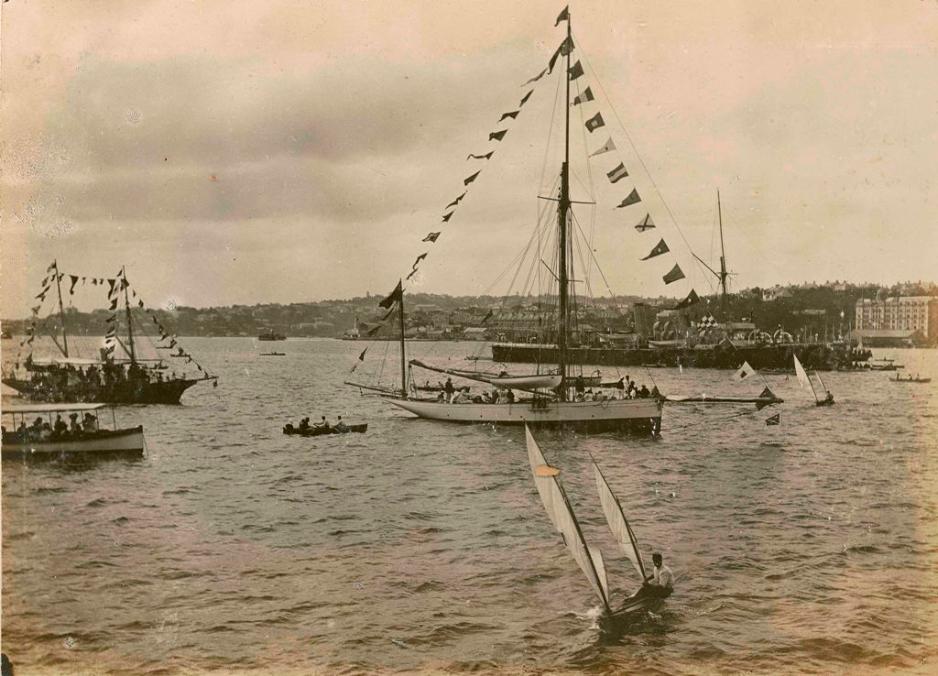
Above: Prince Alfred Yacht Club Regatta - 1895 - Bronzewing and Althea (steamship in background) with yacht
This photograph belongs to a professionally produced album that contains 9 photographs of the 1895 Prince Alfred Yacht Club Regatta. The Prince Alfred Yacht Club is believed to have been first established on 15 October 1867 and received its Royal designation in 1911. The club is still in operation and is located at Green Point, Newport on Sydney's northern beaches. On the 14 December 1895 the club held a regatta on Sydney Harbour for a variety of sailing and rowing vessels. The Commodore Samuel Hordern was in command of the steam yacht BRONZEWING on the day and was accompanied by the flagship ALATHEA. ANMM Collection 00019553 [05 & 07] courtesy Australian National Maritime Museum.
Prince Alfred Yacht Club Regatta.
Favored by lovely weather, the annual regatta of the Prince Alfred Yacht Club, which was held in Farm Cove on Saturday afternoon, proved a most pronounced success. The scene In the Cove during the regatta was one of great beauty and animation, racing and pleasure craft of all description being afloat. The Alathea (flagship) was crowded with spectators, and the steam yachts White Star, Isis, and Bronzewing, together with the sailing yachts Era, Sirocco, Jess, and Athena, moored close by, were decked out in flags from stem to stern. On the flagship a good string band played enjoyable music, and light refreshments were supplied on board. The entries for the various events were extraordinarily large, and some capital races took place. The officers for the day were as follow: — Handicapper and judge (rowing), Mr. J. Blackman; judge and time keeper (sailing), Messrs. F. Donovan and G. Hel lings, also handicappers for sailing boats; handicappers (yachts), Messrs. F. S. Adams, W. H. Ballard and W. M. Calvert; judge and starter (rowing), Mr. King Gutinan, The hon. secretary (Mr. J. H. Harris) discharged his duties most efficiently, on the flagship. The results are as follow: — SAILING RACES. Eight-feet Dingeys. Our Boys 1 Thistle 2, Ten-feet Dingeys. : Vero 1 Racine 2; Viking 3 Fourteen-feet Dingeys. Saucy Jack 1 Vision 2 Young Victor 3 Canoes not exceeding 16ft. | My Favorite (W. W. M'Naughton), scr 1 Effra (T. Redmond), 2min 2 Ysabel (W. J. Redmond), 4min 3 Other starters were: Ernie, Mona, Joker, May, Gipsy. All boats 18ft to 24ft (handicapped). Ida (J. M'Murtrie), 24ft scr 1 Ine7. (J. Doran), 18ft, 5 ½ min 2 Lottie (P. Roberts), 24ft, lmin, and Flying Fish (M. Foy), 24ft, lmin, tied for third place. The total number of boats in this race was twenty-four, among them being many well-known flyers, and the race was a most interesting one. Yachts, one-rating, and under. Cariad (J. George), -54min1 Gnome (J. O. Fairfax), -50, 3min 2 Taipo (W. Hunt), -54 2 ½ min 3 Buttercup Netta, Sita, Daisy, and Wee Won also started. Cairad won on her time allowance, and Gnome has protested against her for a foul. Half-decker boats (fore-and-aft canvas only). Spray (J. E. Chinnery) 1 Rowena (Dr. Power) 2 Warringah (A. Carmichael) 3 Other starters: Nyee (G. W. Cannis), and Sorais (W. H. Pacey). Won by 6min, second and third boats being separated by 4sec. All yachts (handicapped). Bronzewing (H. M. Cockshott), 2 ½ rating, scr 1 Herreshoff (J. Cox), 5 rating, scr 2 Lahloo (W. H. Murrell), 3 -50 rating, 3min 3 Norna (J. E. O'Brien) 3%min, and Vesta (J. Beal), scr, also started. At first Herreshoff was in front, but after a while was displaced by Bronzewing, who led to the end of the race, and finished about 2min ahead of Hereshoff. All boats, sailed by those who have never won at a public regatta. Limited sails. Young Henry (H. Pearce) 25ft, scr 1 Enterprise (George Robinson), 24ft, lmin 2 Craigielee (G. Demos), 24ft, 2min 3 There was a very large list of boats in this race, and after an interesting contest, Young Henry won from Enterprise by 2min 22sec. Aquatics. (1895, December 16 - Monday). Evening News (Sydney, NSW : 1869 - 1931), p. 2. Retrieved from http://nla.gov.au/nla.news-article108076957
Below: Prince Alfred Yacht Club Regatta - 1895 - Bronzewing with Ena II to left side
